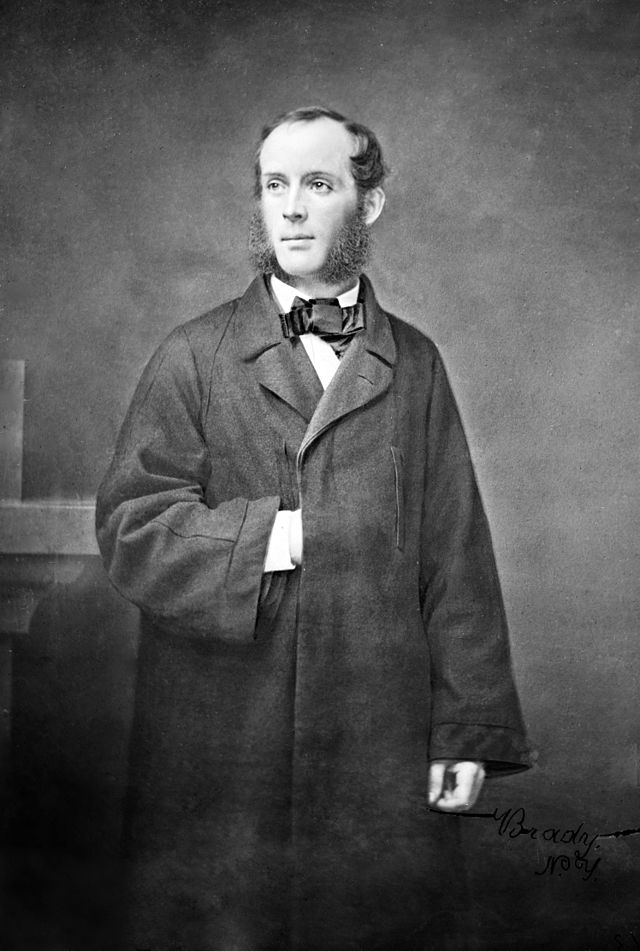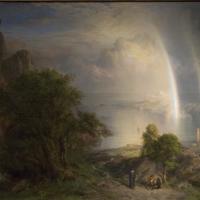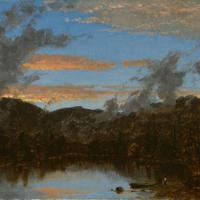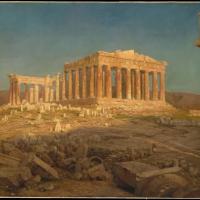Frederic Edwin Church (May 4, 1826 – April 7, 1900) was an American landscape painter born in Hartford, Connecticut. He was a central figure in the Hudson River School of American landscape painters, best known for painting large landscapes, often depicting mountains, waterfalls, and sunsets. Church's paintings put an emphasis on realistic detail, dramatic light, and panoramic views. He debuted some of his major works in single-painting exhibitions to a paying and often enthralled audience in New York City. In his prime, he was one of the most famous painters in the United States.

Church began his career by painting classic Hudson River School scenes of New York and New England, but by 1850, he had settled in New York. He exhibited his art at the American Art Union, the Boston Art Club, and (most impressively for a young artist) the National Academy of Design. His method consisted of creating paintings in his studio based on sketches in nature. In the earlier years of his career, Church's style was reminiscent of that of his teacher, Thomas Cole, and epitomized the Hudson River School's founding styles. As his style progressed he departed from Cole's approach: he painted in more elaborate detail and his compositions became more adventurous in format, sometimes with dramatic light effects.
Church made two trips to South America in 1853 and 1857 and stayed predominantly in Quito, Ecuador. The first trip was with businessman Cyrus West Field, who financed the voyage, hoping to use Church's paintings to lure investors to his South American ventures. Church was inspired by Alexander von Humboldt's exploration of the continent in the early 1800s; Humboldt had challenged artists to portray the "physiognomy" of the Andes. After Humboldt's Personal Narrative of Travels to the Equinoctial Regions of America was published in 1852, Church jumped at the chance to travel and study in Humboldt's footsteps. When Church returned in 1857 with painter Louis Rémy Mignot, he added to his landscape paintings of the area. After both trips, Church had produced a number of landscapes of Ecuador and the Andes, such as The Andes of Ecuador (1855), Cayambe (1858), The Heart of the Andes (1859), and Cotopaxi (1862). The Heart of the Andes, Church's most famous painting, pictures several elements of topography combined into an idealistic, broad portrait of nature. The painting was very large, yet highly detailed; every species of plant and animal is identifiable and numerous climate zones appear at once.
As he had with Niagara before, Church debuted The Heart of the Andes in a single-painting exhibition in New York City. Thousands of people paid to see the painting, with the painting's huge floor-based frame playing the part of a window looking out on the Andes. The audience sat on benches to view the piece, sometimes using opera glasses to get close, and Church strategically darkened the room with a spotlight on the painting. The work was an instant success. Church eventually sold it for $10,000, at that time the highest price ever paid for a work by a living American artist.
During the Civil War, Church was inspired to paint Our Banner in the Sky, from which a lithograph was made and sold to benefit the families of Union soldiers. In 1863, he was elected an Associate Fellow of the American Academy of Arts and Sciences.
By 1860, Church was the most renowned American artist. In his prime, Church was a commercial as well as an artistic success. Church's art was very lucrative; he was reported to be worth half a million dollars at his death in 1900.
In the last decades of his life Church's fame dwindled, and by his death in 1900 there was little interest in his work. His paintings were seen as part of an "old-fashioned and discredited" school that was too devoted to details. His reputation improved with a 1945 exhibition devoted to the Hudson River School at the Art Institute of Chicago, and that year the Metropolitan Museum of Art Bulletin revisited the original reception of The Heart of the Andes. In 1960 art historian David C. Huntington completed a dissertation on Church that explored his influences and milieu. By 1966 he had written a monograph on Church and organized the first exhibition devoted to Church since his death, for the National Collection of Fine Arts. Church's legacy was rekindled; American museums began to acquire his works, and by 1979 Church's The Icebergs sold for $2.5 million, then the third-highest auction for any work of art. The next year the National Gallery of Art held a major exhibition, American Light: The Luminist Movement, 1825–1875, which positioned Church as the leading American painter of his time.
Church's paintings, more confident and on a grander scale than those of his contemporaries, uniquely captured the spirit of an optimistic American people who associated the landscape of the New World with manifest destiny. Art historian Barbara Novak wrote that Church was "a paradigm of the artist who becomes the public voice of a culture, summarizing its beliefs, embodying its ideas, and confirming its assumptions."
Olana State Historic Site is now owned and operated by the New York State Office of Parks, Recreation and Historic Preservation, Taconic Region, and receives extensive support from The Olana Partnership, a private, non-profit organization.




